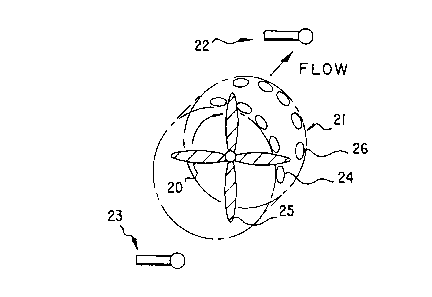Some of the information on this Web page has been provided by external sources. The Government of Canada is not responsible for the accuracy, reliability or currency of the information supplied by external sources. Users wishing to rely upon this information should consult directly with the source of the information. Content provided by external sources is not subject to official languages, privacy and accessibility requirements.
Any discrepancies in the text and image of the Claims and Abstract are due to differing posting times. Text of the Claims and Abstract are posted:
| (12) Patent: | (11) CA 2200558 |
|---|---|
| (54) English Title: | DUCTED AXIAL FAN |
| (54) French Title: | VENTILATEUR AXIAL A ENVELOPPE |
| Status: | Expired and beyond the Period of Reversal |
| (51) International Patent Classification (IPC): |
|
|---|---|
| (72) Inventors : |
|
| (73) Owners : |
|
| (71) Applicants : |
|
| (74) Agent: | KIRBY EADES GALE BAKER |
| (74) Associate agent: | |
| (45) Issued: | 2000-12-19 |
| (86) PCT Filing Date: | 1995-10-11 |
| (87) Open to Public Inspection: | 1996-07-04 |
| Examination requested: | 1997-03-20 |
| Availability of licence: | N/A |
| Dedicated to the Public: | N/A |
| (25) Language of filing: | English |
| Patent Cooperation Treaty (PCT): | Yes |
|---|---|
| (86) PCT Filing Number: | PCT/US1995/017138 |
| (87) International Publication Number: | WO 1996020347 |
| (85) National Entry: | 1997-03-20 |
| (30) Application Priority Data: | ||||||
|---|---|---|---|---|---|---|
|
The present invention relates to a ducted axial fan for large diameter ducts.
The
invention is comprised of equidistantly spaced sensors upstream and downstream
of the
axial fan and spaced actuators located around the periphery of the duct to
cancel tonal
noise caused by the air turbulence generated by the rotation of the fan.
Ventilateur axial à enveloppe conçu pour des conduits à diamètre important (11) et comprenant des détecteurs (22, 23) placés à des positions équidistantes en amont et en aval d'un ventilateur axial, ainsi que des organes de commande (24, 26) placés autour de la circonférence dudit conduit afin d'annuler le bruit tonal provoqué par la turbulence de l'air produite par la rotation du ventilateur.
Note: Claims are shown in the official language in which they were submitted.
Note: Descriptions are shown in the official language in which they were submitted.

2024-08-01:As part of the Next Generation Patents (NGP) transition, the Canadian Patents Database (CPD) now contains a more detailed Event History, which replicates the Event Log of our new back-office solution.
Please note that "Inactive:" events refers to events no longer in use in our new back-office solution.
For a clearer understanding of the status of the application/patent presented on this page, the site Disclaimer , as well as the definitions for Patent , Event History , Maintenance Fee and Payment History should be consulted.
| Description | Date |
|---|---|
| Time Limit for Reversal Expired | 2008-10-14 |
| Letter Sent | 2007-10-11 |
| Inactive: IPC from MCD | 2006-03-12 |
| Grant by Issuance | 2000-12-19 |
| Inactive: Cover page published | 2000-12-18 |
| Inactive: Final fee received | 2000-09-11 |
| Pre-grant | 2000-09-11 |
| Notice of Allowance is Issued | 2000-03-24 |
| Notice of Allowance is Issued | 2000-03-24 |
| Letter Sent | 2000-03-24 |
| Inactive: Approved for allowance (AFA) | 2000-03-02 |
| Amendment Received - Voluntary Amendment | 1999-11-01 |
| Inactive: S.30(2) Rules - Examiner requisition | 1999-07-30 |
| Inactive: IPC assigned | 1997-08-18 |
| Inactive: First IPC assigned | 1997-08-18 |
| All Requirements for Examination Determined Compliant | 1997-03-20 |
| Request for Examination Requirements Determined Compliant | 1997-03-20 |
| Application Published (Open to Public Inspection) | 1996-07-04 |
There is no abandonment history.
The last payment was received on 2000-09-27
Note : If the full payment has not been received on or before the date indicated, a further fee may be required which may be one of the following
Please refer to the CIPO Patent Fees web page to see all current fee amounts.
| Fee Type | Anniversary Year | Due Date | Paid Date |
|---|---|---|---|
| Registration of a document | 1997-03-20 | ||
| Request for examination - standard | 1997-03-20 | ||
| Basic national fee - standard | 1997-03-20 | ||
| MF (application, 2nd anniv.) - standard | 02 | 1997-10-14 | 1997-09-24 |
| MF (application, 3rd anniv.) - standard | 03 | 1998-10-13 | 1998-09-28 |
| MF (application, 4th anniv.) - standard | 04 | 1999-10-11 | 1999-09-28 |
| Final fee - standard | 2000-09-11 | ||
| MF (application, 5th anniv.) - standard | 05 | 2000-10-11 | 2000-09-27 |
| MF (patent, 6th anniv.) - standard | 2001-10-11 | 2001-09-19 | |
| MF (patent, 7th anniv.) - standard | 2002-10-11 | 2002-09-18 | |
| MF (patent, 8th anniv.) - standard | 2003-10-13 | 2003-09-17 | |
| MF (patent, 9th anniv.) - standard | 2004-10-11 | 2004-09-16 | |
| MF (patent, 10th anniv.) - standard | 2005-10-11 | 2005-09-19 | |
| MF (patent, 11th anniv.) - standard | 2006-10-11 | 2006-09-20 |
Note: Records showing the ownership history in alphabetical order.
| Current Owners on Record |
|---|
| NOISE CANCELLATION TECHNOLOGIES, INC. |
| Past Owners on Record |
|---|
| JEFFREY N. DENENBERG |